A군 베타 용혈성 연쇄상구균 감염 후 급성 사구체 신염 (A군 연구균 감염 후 급성 사구체 신염, 급성 연쇄상구균성 사구체 신염) Post-streptococcal acute glomerulonephritis
-
A군 β(베타) 용혈성 연쇄상구균을 편의상 A군 연구균 또는 A군 연쇄상구균으로 칭한다.
-
A군 β 용혈성 연쇄상구균에는 여러 종류의 균종으로 세분된다. 그 균종 중 급성 사구체 신염을 일으킬 수 있는 A군 베타 용혈성 연쇄상구균의 한 가지 균종에 의하여 생긴 인두염이나 인두편도염, 피부염 또는 농가진([부모도 반의사가 되어야 한다–소아가정간호백과]-제6권 신생아 성장 발육 양호 및 질환 –신생아 농가진,
-
제7권 소아청소년 감염병 –농가진, 성홍열 참조) 등을 앓는 도중이나 앓고 난 후 9∼11일 경에 A군 베타 용혈성 연쇄상구균 항원 항체 이상반응으로 사구체가 손상되어 A군 연쇄상구균 감염 후 급성 사구체 신염이 발생될 수 있다.
-
A군 연쇄상구균 감염으로 인한 농가진이나 편도염 등을 앓을 때에는 조기에 적절히 치료해야 한다.
-
A군 연쇄상구균 감염병을 앓는 어떤 아이는 A군 연쇄상구균 감염 후 급성 사구체 신염에 걸릴 수 있고, 또 다른 아이는 그 병에 걸리지 않는 이유는 아직도 확실히 모르지만 체질에 따라 다른 것이라고 추정된다.
-
A군 연쇄상구균 감염에 의한 감염병이 많이 유행하는 늦은 겨울철이나 이른 봄철에 A군 연쇄상구균 감염 후 급성 사구체 신염에 더 잘 걸릴 수 있고, 남아가 여아보다 더 잘 걸린다.
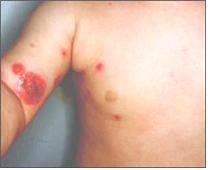
사진 1-62. 유아에게 생긴 A군 연쇄상구균성 농가진.
A군 연쇄상구균 감염 후 급성 사구체 신염을 일으킬 수 있는 항원을 가진 A군 연쇄상구균성 농가진을 앓을 때, A군 연쇄상구균 감염 후 급성 사구체 신염이 생길 수 있다.
Copyrightⓒ 2011 John Sangwon Lee,MD., FAAP
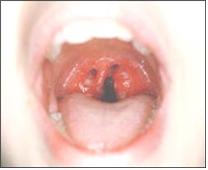
사진 1-63.A군 연쇄상구균 감염 후 급성 사구체 신염을 일으킬 수 있는 항원을 가진 A군 연쇄상구균성 편도염이나 인두염을 앓을 때, A군 연쇄상구균 감염 후 급성 사구체 신염이 생길 수 있다. Copyrightⓒ 2011 John Sangwon Lee, MD., FAAP
A군 베타 용혈성 연쇄상구균 감염 후 급성 사구체 신염의 증상 징후
-
A군 연쇄상구균 감염 후 급성 사구체 신염을 아주 경미하게 앓을 수도 있고, 생명을 위협할 수 있을 정도로 심하게 앓을 수도 있다.
-
경미한 A군 연쇄상구균 감염 후 급성 사구체 신염의 증상 징후는, A군 연쇄상구균 감염 후 급성 사구체 신염을 일으킨 A군 β 용혈성 연쇄상구균에 의한 감염병의 증상 징후와 A군 연쇄상구균 감염 후 급성 사구체 신염의 증상 징후가 함께 나타날 수 있다.
-
A군 연쇄상구균 감염 후 급성 사구체 신염에 걸려 있지만 증상 징후는 별로 없고 다만 현미경 소변검사나 소변 화학 검사를 할 때 소변 속에 피가 비정상적으로 조금 나오는 것을 보고, A군 연쇄상구균 감염 후 급성 사구체 신염에 걸린 것을 처음으로 진단받을 때도 있다.
-
이런 때에는 소변에 현미경적 혈뇨 이외 다른 증상 징후는 거의 없다.
-
A군 연쇄상구균 감염 후 생긴 급성 사구체 신염에 심하게 걸렸을 때에는, 신장 부전증(신부전증)도 생길 수 있다.
-
이 때 신장이 소변을 정상적으로 분비할 수 없기 때문에, 소변이 조금도 나오지 않을 수 있고 몸 전체가 부을 수 있다.
-
A군 연쇄상구균 감염 후 급성 사구체 신염은 특수 균종의 A군 베타 용혈성 연쇄상구균의 감염에 의한 A군 연구균 농가진이나 편도염·인두염․인두편도염․단독·성홍열 등을 앓기 시작한 지 9∼11일 경에 발병되는 것이 보통이다.
-
A군 연쇄상구균 감염병을 앓은 후 급성 사구체 신염이 발병되면, 초기에 새빨간 피나 커피색 피가 소변으로 나오는 것이 보통이다.
-
소변의 양이 현저히 줄어들어 하루 종일 소변을 아주 조금 볼 수 있고, 또 신장의 사구체에서 소변이 거의 분비되지 않을 수 있다.이때는 방광 속에 소변이 하나도 없고 물론, 소변을 조금도 보지 못한다. 이때 얼굴과 몸 전체가 부을 수 있다.
-
미열 내지 고열이 나고, 보채며 아파한다. 복통과 두통을 호소하고, 코피가 날 수 있다.
-
고혈압이 생길 수 있고, 때로는 전신 경련, 심장 부전증, 심장 쇠약증 등이 생길 수 있고, 신증후군도 생길 수 있다.
-
이런 심한 합병증은 보통 4∼10일 정도 계속된다.
-
이 병이 잘 치료되면, 소변에 피가 더 이상 나오지 않거나 아주 조금 나온다.
-
모든 증상 징후 중 한 달 동안에 하나 둘씩 서서히 없어지며, 마지막으로 완전히 회복되는 것이 보통이다.
-
그렇지만, 발병 후 1년 정도 지나야 혈뇨가 더 이상 나오지 않는 것이 보통이다.
A군 베타 용혈성 연쇄상구균 감염 후 급성 사구체 신염의 진단
-
병력·증상 징후·진찰소견 등을 종합하여 이 병이 의심되면, 피검사와 소변검사, 가슴 X-선 검사, 그리고 편도염, 인두염, 인두편도염, 또는 농가진 병소에서 얻은 피 검물로 A군 연구균 세균 배양 검사를 해 진단한다.
- 또 급성 사구체 신염이 발병되기 바로 며칠 전에 A군 연쇄상구균에 의한 인두염·편도염·인두편도염․농가진·단독·성홍열 등의 A군 연쇄상구균성 감염병을 앓았던 병력이 있거나 현재 그런 감염병을 앓고 있으면, 이 병을 진단하는 데 큰 도움이 된다.
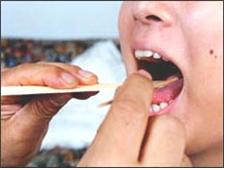
사진 1-64. A군 β 용혈성 연쇄상구균성 인두염이나 편도염이 있나 알아보기 위해 입안을 진찰한다. Copyrightⓒ 2011 John Sangwon Lee,MD., FAAP
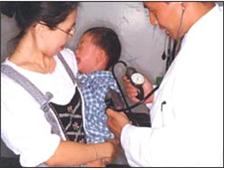
사진 1-65. 이 병이 있으면 고혈압이 생길 수 있다.그래서 혈압을 자주 재야한다.
Copyrightⓒ 2011 John Sangwon Lee, MD., FAAP
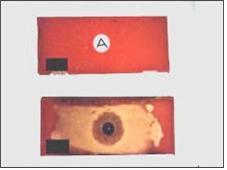
사진 1-66. A군 β 용혈성 연쇄상구균성 농가진이나 인두염 또는 편도염을 진단하기 위해 A군 β 용혈성 연쇄상구균성 세균 배양 검사를 한다. 이 검사를 스트렙트 검사 또는 Throat culteul라고 부르기도 한다.
Copyrightⓒ 2011 John Sangwon Lee, MD., FAAP
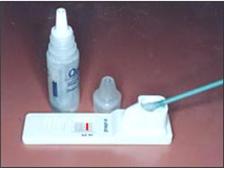
사진 1-67. A군 β 용혈성 연쇄상구균성 농가진이나 인두염 또는 편도염을 진단하기 위해 A군 β 용혈성 연쇄상구균성 항원 항체 응집 반응 검사를 한다.
Copyrightⓒ 2011 John Sangwon Lee, MD., FAAP

사진 1-68. A군 연쇄상구균 감염 후 생긴 급성 사구체 신염을 진단하기 위해 소변을 영아 소변 주머니나 컵에 받는다. 소변 검사를 한다
Copyrightⓒ 2011 John Sangwon Lee,MD. FAAP

사진 1-69. 혈뇨, 농뇨, 단백뇨가 있는지 알아보기 위해 멀티스틱스 소변 화학 검사를 한다. A군 연쇄상구 균 감염 후 생긴 급성 사구체 신염이 있을 때, 혈뇨, 농뇨, 단백뇨가 있을 수 있다.Copyrightⓒ 2011 John Sangwon Lee,MD., FAAP
A군 베타 용혈성 연쇄상구균 감염 후 급성 사구체 신염의 치료
-
-
증상 징후와 병세의 정도, 합병증의 유무 등에 따라 치료한다.
-
A군 연쇄상구균 감염 후 급성 사구체 신염에 아주 경미하게 걸려 있을 때는 A군 연쇄상구균성 편도염이나 농가진 등을 적절한 항생제로 신속히 치료하고 그 사구체 신염의 치료는 조심스럽게 관찰하는 것이 치료의 전부이다.
-
A군 연쇄상구균 감염 후 급성 사구체 신염을 심하게 앓을 때에는 집중치료실에서 치료 받아야 한다.
-
이 병을 적절히 잘 치료하면 2주 내에 거의 회복된다.
-
그러나 혈중 나트륨(소듐), 칼륨, 그 외 다른 여러 종류의 전해질의 불균형으로 생명이 위협 받을 수 있다.
-
그런 이유로 혈중 전해질 농도 피검사를 자주 해서 혈중 전해질 불균형이 생기지 않게 예방하고, 전해질 불균형과 그로 인해 생기는 증상 징후를 적절히 치료해야 한다.
-
혈압이 상당히 높이 올라가 고혈압이 생기면 전신 경련, 두통, 신경마비, 혼미, 기민 상태 등의 증상 징후가 생길 수 있다. 고혈압이 더 이상 계속 되지 않도록 수분 섭취를 제한하기도 하고, 음식물 섭취로 조절한다.
-
또 필요에 따라 디아족사이드(Diazoxide), 푸로세마이드(Furosemide), 나이트로푸루시드(Nitroprusside), 하이드랄라진(Hydralazine) 등의 이뇨제 중 두세 가지의 이뇨제로 치료한다.
-
전신 경련이 생기면, 전신 경련과 고혈압을 적절히 치료한다. 이 때 밸리움(Valium)이나 딜란틴(Dilantin) 등으로 치료하기도 한다. 또 심장 쇠약을 적절히 치료한다.
-
A군 연쇄상구균 감염에 의한 감염병을 치료하기 위해 페니실린이나 다른 종류의 항생제로 적어도 10일간 치료한다.
-
몹시 아플 때에는 육체적·정신적 안정을 취한다.
-
병세가 점차로 좋아지면서 기분이 좋아지고 기력이 나면, 집안에서 적절한 육체적 활동을 시작할 수 있다.
-
이 병이 거의 회복된 후, 육체적 운동을 조금 더 해도 소변에 피가 더 많이 섞여 나오지는 않는 것이 보통이다.
-
이 병의 증상 징후와 이 병의 진행 경과에 따라 음식물 섭취를 조절해야 한다.
-
신장 부전증으로 소변의 양이 아주 적을 때는 칼륨·단백질·소금·수분의 섭취량을 적절히 제한한다.
-
소변이 비정상적으로 아주 적게 분비되는 동안, 단백질 섭취량을 적절히 제한하고, 탄수화물류와 지방질류 음식물을 주로 먹어야 한다.
-
심한 A군 연쇄상구균 감염 후 급성 사구체 신염으로 폐포 속에 체액이 가득 차거나, 심장부전증이 있거나, 심한 고혈압이 있으면서 잘 치료되지 않을 때에는 투석 치료를 한다.
-
또 전신 경련을 하거나 혈중 칼륨이나 나트륨(소듐) 등의 전해질 불균형이 심하게 생길 때는 투석 치료를 한다.
-
A군 연쇄상구균 감염에 의한 인두염·편도염․인두편도염·농가진 등을 조기에 적절히 치료해도, A군 연쇄상구균 감염 후 생기는 급성 사구체 신염을 완전히 예방할 수 없다.
-
그러나 이런 감염병을 조기에 치료하지 않고 오랫동안 방치할수록, A군 연쇄상구균 감염 후 급성 사구체 신염에 걸릴 확률이 더 높다.
-
A군 연쇄상구균성 편도염이나 농가진 등의 감염병이 생기면, 가능한 한 빨리 적절히 치료해야 한다.
-
이 때 다른 식구들도 A군 연구균 농가진이나 편도염을 앓고 있거나 A군 연쇄상구균을 보균하고 있으면, 페니실린이나 에리스로마이신 등 적절한 항생제로 치료해야 한다.
-
대수롭지 않게 생각했던 A군 연쇄상구균 감염성 부스럼이나 항문 주위염 등을 조기 치료하지 않으면, A군 연쇄상구균 감염 후 급성 사구체 신염이나 류마티스 열이나 류마티스 관절염 등에 걸릴 수 있다.
-
부스럼 등 A군 연구균 감염병 을 빨리 적절히 치료해 A군 연쇄상구균 감염 후 급성 사구체 신염 등에 걸리지 않도록 한다. [부모도 반의사가 되어야 한다–소아가정간호백과]-제7권 소아청소년 감염병-A군 연구균에 의한 감염병 참조
-
Acute glomerulonephritis after group A beta hemolytic streptococcal infection (acute glomerulonephritis after group A infection, acute streptococcal glomerulonephritis) Post-streptococcal acute glomerulonephritis A군 베타 용혈성 연쇄상구균 감염 후 급성 사구체 신염 (A군 연구균 감염 후 급성 사구체 신염, 급성 연쇄상구균성 사구체 신염)
Post-streptococcal acute glomerulonephritis
• Group A β (beta) hemolytic streptococcus is referred to as group A research bacteria or group A streptococcus for convenience.
• Group A β hemolytic streptococcus is subdivided into several types. Pharyngitis, pharyngeal tonsillitis, dermatitis or impetigo caused by one of the group A beta hemolytic streptococcus which can cause acute glomerulonephritis Good growth and development and diseases-impetigo in newborns,
• Acute glomeruli after group A streptococcal infection due to adverse reactions of group A beta hemolytic streptococcus antigen antibodies during or 9-11 days after suffering from vol. 7 pediatric infectious diseases-impetigo, scarlet fever) Nephritis may develop.
• If you suffer from impetigo or tonsillitis caused by group A streptococcal infection, you should be treated appropriately at an early stage.
• Some children with group A streptococcal infection may develop acute glomerulonephritis after group A streptococcal infection, and the reason why others do not get the disease is still unknown, but it is estimated that it depends on the constitution.
• Acute glomerulonephritis after group A streptococcal infection is more prevalent in late winter or early spring, when infectious diseases caused by group A streptococcal infection are prevalent, and boys are more prone to acute glomerulonephritis than girls.

Photo 1-62. Group A streptococcal impetigo in infants. Acute glomerulonephritis may develop after group A streptococcal infection when a group A streptococcal impetigo has an antigen that can cause acute glomerulonephritis after group A streptococcal infection. Copyrightⓒ 2011 John Sangwon Lee, MD., FAAP

Picture 1-63. Group A streptococcal tonsillitis or pharyngitis with antigens that can cause acute glomerulonephritis after group A streptococcal infection may result in acute glomerulonephritis after group A streptococcal infection. Copyrightⓒ 2011 John Sangwon Lee, MD., FAAP
Symptoms and signs of acute glomerulonephritis after group A beta hemolytic streptococcal infection
• Acute glomerulonephritis after group A streptococcal infection may be very mild or life-threatening.
• Symptoms of acute glomerulonephritis after mild group A streptococcal infection include group A β hemolytic streptococcus infectious disease symptoms and symptoms of acute glomerulonephritis after group A streptococcal infection. Symptoms may be accompanied by signs.
• Acute glomerulonephritis after group A streptococcal infection, but there are no signs of symptoms. However, when a microscopic urine test or urine chemistry test was performed, a little abnormal blood was observed in the urine, and after group A streptococcal infection, acute glomerulonephritis occurred. Sometimes it’s the first time you’re diagnosed with it.
• At these times, there are few signs of symptoms other than microscopic hematuria in the urine.
• If you are severely affected by acute glomerulonephritis after a group A streptococcal infection, kidney failure (renal failure) may also develop.
• At this time, since the kidneys cannot secrete urine normally, no urine may come out and the entire body may be swollen.
• Acute glomerulonephritis after group A streptococcal infection is 9-11 days after starting to suffer from group A research bacteria impetigo or tonsillitis, pharyngitis, pharyngitis tonsillitis, alone, scarlet fever, etc., caused by infection of group A beta hemolytic streptococcus of a special strain It is common to develop
• When acute glomerulonephritis develops after suffering from group A streptococcal infectious disease, it is common to initially release bright red or coffee-colored blood in the urine. • The amount of urine is significantly reduced, so you can urinate very little throughout the day, and there may be very little urine output from the glomeruli of the kidneys, when there is no urine in the bladder, and of course, you cannot urinate at all. At this time, the entire face and body may be swollen.
• I have a mild or high fever, and feel sick and sick. Complaining of abdominal pain and headache, and nosebleeds may occur.
• High blood pressure can develop, sometimes systemic cramps, heart failure, heart weakness, and nephrotic syndrome.
• These severe complications usually last 4 to 10 days.
• If the disease is treated well, there is no more or very little bleeding in the urine.
• All symptomatic signs disappear slowly one by one over the course of a month, and finally recover completely.
• However, it is common for hematuria to no longer occur until about a year after the onset.
Diagnosis of acute glomerulonephritis after group A beta hemolytic streptococcal infection
• If the disease is suspected by combining medical history, symptoms, and examination findings, blood and urine tests, chest X-rays, and specimens obtained from tonsillitis, pharyngitis, pharyngeal tonsillitis, or impetigo are used as group A research bacteria. Diagnose by performing a bacterial culture test.
• In addition, if you have a history of or are currently suffering from group A streptococcal infectious diseases such as group A streptococci, pharyngitis, tonsillitis, pharyngeal tonsillitis, impetigo, alone, scarlet fever just days before the onset of acute glomerulonephritis, It’s a great help in diagnosing this disease.

Photo 1-64. Group A β Examine your mouth to see if you have hemolytic streptococcal pharyngitis or tonsillitis. Copyrightⓒ 2011 John Sangwon Lee, MD., FAAP

Photo 1-65. This disease can lead to high blood pressure, so your blood pressure should be checked frequently. Copyrightⓒ 2011 John Sangwon Lee, MD., FAAP

Photo 1-66. To diagnose group A β hemolytic streptococcal impetigo, pharyngitis or tonsillitis, a group A β hemolytic streptococcal bacterial culture test is performed. This test is sometimes referred to as the strept test or Throat culteul. Copyrightⓒ 2011 John Sangwon Lee, MD., FAAP

Photo 1-67. To diagnose group A β hemolytic streptococcal impetigo, pharyngitis, or tonsillitis, a group A β hemolytic streptococcal antigen antibody agglutination test is performed. Copyrightⓒ 2011 John Sangwon Lee, MD., FAAP

Photo 1-68. In order to diagnose acute glomerulonephritis after group A streptococcal infection, urine is received in an infant’s urine bag or cup. Do a urine test Copyrightⓒ 2011 John Sangwon Lee, MD. FAAP

Photo 1-69. A multistick urine chemistry test is done to see if you have hematuria, pyuria, or proteinuria. When there is acute glomerulonephritis after group A streptococcal infection, hematuria, pyuria, and proteinuria may be present. Copyright© 2011 John Sangwon Lee, MD., FAAP
Treatment of acute glomerulonephritis after group A beta hemolytic streptococcal infection
• o Treat according to symptoms, severity of illness, and presence or absence of complications.
o When acute glomerulonephritis is very mild after group A streptococcal infection, the treatment of group A streptococcal tonsillitis or impetigo is promptly treated with appropriate antibiotics and the treatment of glomerulonephritis is carefully observed.
o If you suffer from acute glomerulonephritis after group A streptococcal infection, you should be treated in an intensive care unit.
o If the disease is treated properly and well, it will almost recover within 2 weeks.
o However, imbalances in sodium (sodium), potassium, and many other electrolytes in the blood can be life threatening.
o For that reason, blood electrolyte concentration blood tests should be performed frequently to prevent the occurrence of blood electrolyte imbalance, and the electrolyte imbalance and symptoms resulting from it should be treated appropriately.
o When blood pressure rises considerably high and high blood pressure occurs, symptoms such as general convulsion, headache, nerve palsy, confusion, and alertness may occur. Water intake is also limited to prevent high blood pressure from continuing, and is controlled with food intake.
o In addition, if necessary, treatment with two or three diuretics of diuretics such as Diazoxide, Furosemide, Nitroprusside, and Hydralazine.
o If systemic convulsions occur, systemic convulsions and hypertension are treated appropriately. At this time, it is sometimes treated with Valium or Dilantin. It also treats heart weakness appropriately.
o To treat infectious diseases caused by group A streptococcal infection, treatment with penicillin or other antibiotics for at least 10 days.
o Get physical and mental stability when you are very sick. o As you gradually feel better and feel better and more energized, you can begin proper physical activity in your home.
o After the disease has almost recovered, it is common that even a little more physical exercise does not cause more blood to come out in the urine.
o Food intake should be adjusted according to the symptoms of the disease and the course of the disease.
o When the amount of urine is very low due to kidney failure, adequately limit the intake of potassium, protein, salt, and moisture.
o During abnormally very little urine output, adequately limit protein intake and eat mainly carbohydrates and fatty foods.
o Dialysis treatment is performed when the alveolar fluid is filled with fluid in the alveoli due to acute glomerulonephritis after a severe group A streptococcal infection, heart failure, or severe hypertension is present.
o In addition, dialysis treatment is used when systemic convulsions or an electrolyte imbalance such as potassium or sodium (sodium) in the blood develops.
o Even with early and appropriate treatment of pharyngitis, tonsillitis, pharyngeal tonsillitis and impetigo caused by group A streptococcal infection, acute glomerulonephritis after group A streptococcal infection cannot be completely prevented.
oo However, the longer an infectious disease is left untreated without early treatment, the higher the probability of developing acute glomerulonephritis after group A streptococcal infection. o If an infectious disease such as group A streptococcal tonsillitis or impetigo occurs, it should be treated appropriately as soon as possible.
At this time, if other family members also suffer from group A research bacteria impetigo or tonsillitis, or carry group A streptococcus, they should be treated with appropriate antibiotics such as penicillin or erythromycin.
o If group A streptococcal infectious swelling or perianalitis is not treated early, acute glomerulonephritis, rheumatoid fever, or rheumatoid arthritis may occur after group A streptococcal infection.
o Immediately and appropriately treat infectious diseases of group A research bacteria such as swelling to prevent acute glomerulonephritis after group A streptococcal infection. www.drleepediatrics.com-Volume 7 Children and Adolescent Infectious Diseases-Refer to Infectious Diseases by Group A Research Bacteria
o At this time, other members of the family also
출처 및 참조 문헌 Sources and references
- NelsonTextbook of Pediatrics 22ND Ed
- The Harriet Lane Handbook 22ND Ed
- Growth and development of the children
- Red Book 32nd Ed 2021-2024
- Neonatal Resuscitation, American Academy Pediatrics
- www.drleepediatrics.com 제10권. 소아청소년 신장 비뇨 생식기 질환
- www.drleepediatrics.com 제7권 소아청소년 감염병
- Red book 29th-31st edition 2021
- Nelson Text Book of Pediatrics 19th — 21st Edition
- The Johns Hopkins Hospital, The Harriet Lane Handbook, 22nd edition
-
Childhood Emergencies in the Office, Hospital and Community, American Academy of Pediatrics
-
Emergency Medical Service for Children, By Ross Lab. May 1989. p.10
-
Emergency care, Harvey grant, and Robert Murray
-
Emergency Care Transportation of Sick and Injured American Academy of Orthopaedic Surgeons
-
Emergency Pediatrics A Guide to Ambulatory Care, Roger M. Barkin, Peter Rosen
-
Immediate care of the acutely ill and injured, Hugh E. Stephenson, Jr
-
The Critically Ill Child, Diagnosis and Management, Edited by Clement A. Smith
-
Emergency Medical Services for Children: The Role of the Primary Care Provider, America Academy of Pediatrics
-
Quick Reference To Pediatric Emergencies, Delmer J. Pascoe, M.D., Moses Grossman, M.D. with 26 contributors
-
Manual of Emergency Care
-
응급환자관리 정담미디어
-
소아가정간호백과–부모도 반의사가 되어야 한다, 이상원
-
Neonatal Resuscitation American heart Association
-
Neonatology Jeffrey J.Pomerance, C. Joan Richardson
-
Pediatric Resuscitation Pediatric Clinics of North America, Stephen M. Schexnayder, M.D.
-
Pediatric Critical Care, Pediatric Clinics of North America, James P. Orlowski, M.D.
-
Preparation for Birth. Beverly Savage and Dianna Smith
- Infectious disease of children, Saul Krugman, Samuel L Katz, Ann A. Gershon, Catherine Wilfert
-
The Harriet Lane Handbook 19th Edition
-
소아과학 대한교과서
-
제1권 소아청소년 응급의료 참조문헌과 출처
-
Red Book 29th Edition, American Academy of Pediatrics
- Harriet Lane Handbook 19th ed
- Nelson Pediatric Textbook 19th ed.
- MMWR
- CDC
- 그 외
Copyright ⓒ 2015 John Sangwon Lee, MD., FAAP
“부모도 반의사가 되어야 한다”-내용은 여러분들의 의사로부터 얻은 정보와 진료를 대신할 수 없습니다.
“The information contained in this publication should not be used as a substitute for the medical care and advice of your doctor. There may be variations in treatment that your doctor may recommend based on individual facts and circumstances. “Parental education is the best medicine.”